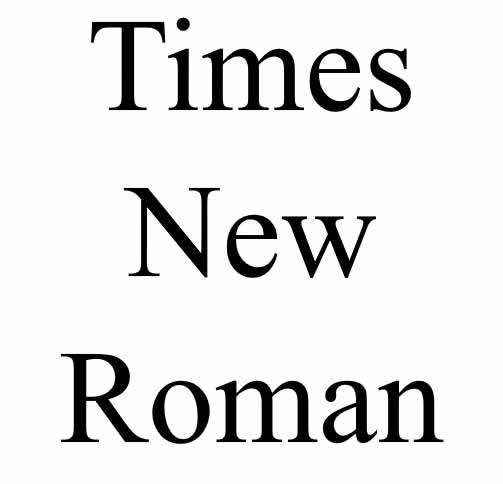
Typography is an integral part of any design project. It sets the tone for the entire piece and can ultimately make or break the overall effectiveness of the design. Unfortunately, even the most experienced designers can fall victim to common typography mistakes that can negatively impact the final product. With that in mind, we’ve compiled a list of 10 common typography mistakes you need to avoid in your designs. Whether you’re a seasoned professional or just starting out, these tips will help you ensure that your typography is on point and your designs are as effective as possible. So, without further ado, let’s dive in and explore the world of typography.

The Basics of Serif Typography
Serif typographies are a popular and enduring design choice in the world of typography. This typeface is distinguished for its small decorative details on the ends of each letter or character, commonly referred to as “serifs”. Serifs can be seen as small lines or curves that adorn the edges of the letters, which contribute to the overall aesthetic appeal of the typography. The serifs can be thick or thin, rounded or pointed, depending on the design of the typeface. Serif typography is often associated with more traditional and formal styles, as it has been used in literature, newspapers, and other printed materials for centuries. However, modern designers have also found creative ways to incorporate serif typography into contemporary designs, creating unique and sophisticated looks. Despite the emergence of newer font styles, serif typography remains a classic and timeless choice for designers looking to create elegant and refined designs.
Next, it is important to note that serif fonts are not just aesthetically pleasing, but they also provide a sense of familiarity and credibility. This is because they have been around for centuries and have been used in various forms of communication such as books, newspapers, and magazines. These fonts have stood the test of time and continue to be relevant today because of their superior legibility and readability. Serif typography has also been proven to increase comprehension and retention of information, making them an excellent choice for educational materials. In conclusion, while there are countless font options available in today’s digital age, serif typography will always remain a top choice for those seeking a classic, timeless and legible font for their print media.
What Are the Most Common Mistakes with Serif Typography?
Typography is one of the most important aspects of design, with serif typography being a popular choice for many. However, one of the most common mistakes when it comes to using serif typography is using a font size that is too small. This can have a detrimental impact on both the readability of the text and the overall look of the design. When font sizes are too small, it becomes difficult for readers to comfortably read the text, which can result in frustration or even a loss of interest in the content. Moreover, small font sizes make it almost impossible for readers with poor eyesight to even engage with the content. When it comes to design, typography is crucial in conveying the message and tone of communication. By using a font size that is too small, the overall look and feel of the design can be negatively impacted. Therefore, it is important to always consider the size and legibility of serif typography when designing any piece of content.
When it comes to using serif fonts in typography, there are a number of things to keep in mind to ensure that the text is legible and visually appealing. One common mistake that people make is to use the wrong line height. As serif fonts have tall ascenders and descenders, it’s important to use a line height that’s appropriate for the size of the font you’re using. Failure to do so can result in cramped or overcrowded text that’s difficult to read. Choosing the right line height is crucial to ensuring that your serif fonts are both attractive and easy on the eye. So, if you want to create typography with serif fonts that stands out, always pay attention to the line height and choose a height that’s suitable for the font you’re using. Remember, fonts are an essential aspect of typography, and choosing the wrong one can have a significant impact on how your content is perceived.
Finally, in the world of typography, serif fonts play an integral role. They are versatile fonts that can aid in developing a design that not only showcases straightforwardness but also contains personality. Utilizing them can enhance the beauty of the text, but it is crucial to use them sparingly in body text. When we use too many serifs on a page, it can become overwhelming and challenging to read. Hence, it is necessary to strike a balance by combining serif and sans-serif fonts to create an appealing design that is easy to understand. A successful typography design is the one that attracts and sustains the reader’s attention while being readable, and serif fonts contribute significantly to achieving that goal.
Strategies to Avoid Common Serif Typography Errors
When discussing serif typographies, it is crucial to begin by familiarizing oneself with the fundamental principles of this font style. These fundamental principles include appropriate sizing for different applications, as well as understanding the effects of kerning, leading, and tracking. These elements can have a significant impact on the overall readability and legibility of a serif font. Additionally, it is important to understand the varying styles and classifications of serif fonts, such as transitional or old-style serifs. By reviewing and understanding these basic principles of choosing, sizing and setting serif fonts, designers can achieve effective typography that not only looks visually appealing, but also serves its intended purpose in conveying information to readers in a clear and concise manner.
When it comes to designing with serif typographies, it is essential to remember the significance of font pairing. Choosing the right fonts and combining them in a way that complements each other can make or break the overall design. The key is to select two fonts that are distinct yet complement each other in a way that enhances the overall message of the design. The combination should not be so similar that it looks like a mistake, nor should they be so dissimilar that they clash and distract from the message. As such, it is crucial to exercise caution when selecting fonts for your design work. In conclusion, font pairing should be treated with the utmost importance when working with serif typographies as it sets the tone for the overall design, and ultimately affects how the brand or message is perceived by the audience.
In conclusion, when it comes to designing with serif typefaces, attention must be given to both the aesthetic and functional aspects. While many serifs may appear similar at first glance, their design nuances and use cases can greatly impact the overall look and feel of a piece. It’s important to consider the context in which the typeface will be used, as this can greatly affect its effectiveness. Whether designing for print or web, understanding the nuances of serif typography is crucial for creating cohesive and effective designs. By taking the time to consider these factors, designers can ensure that their use of serif typefaces is deliberate, functional, and impactful.
Key Takeaways for Avoiding Poor Serif Typography
Serif typography plays a crucial role in modern graphic design, and poor implementation can lead to disastrous results. By understanding the differences between a serif font and sans-serif font, designers can effectively use typography to convey the right tone and message. Serif fonts are characterized by small lines or features called “serifs” that extend from the ends of letters, giving them a more formal and traditional look. On the other hand, sans-serif fonts have a cleaner, more modern appearance due to the absence of serifs. This makes them ideal for body copy, while serif fonts are best suited for headlines and titles. Understanding how to use these fonts correctly can have a significant impact on the overall design of a project, making it imperative to choose the right font for the task at hand. By doing so, designers can create visually appealing and effective typography that captures the essence of their message.
Also, one must keep in mind that serif typography has the potential to convey a certain mood or feeling to the reader. For instance, the use of a classic, formal serif font can evoke a sense of tradition, reliability, and elegance. Conversely, a more modern, sleek serif font can communicate innovation, simplicity, and sophistication. Thus, selecting the appropriate serif font for a particular text or design project can go a long way in effectively communicating the intended message. Ultimately, with careful consideration of font size, spacing, and style, serif typography can be a powerful tool in creating visually compelling and impactful designs.
Conclusion
In conclusion, typography is an essential aspect of design that should never be overlooked. The mistakes mentioned in this post may seem minor, but they can have a significant impact on the overall effectiveness of your design. By avoiding these common typography mistakes, you can ensure that your designs are not only visually pleasing but also easy to read and understand. Remember, good typography is not just about choosing the right font; it’s about creating a harmonious and balanced design that communicates your message effectively. So, take the time to carefully consider your typography choices and make sure they align with your overall design goals. Happy designing!

